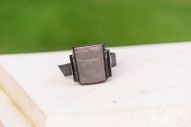http://www.alternet.org/human-rights/electronic-monitoring-restrictive-and-wrong

Photo Credit: View Apart/Shutterstock
Maurice spent over 15 years in Illinois state prisons. Before he was released in the spring of 2015, authorities told him he would have to be on an electronic monitor (EM). “I thought “maybe I’d actually need it,” he told AlterNet. He knew that life was fast on the outside and he figured a monitor might help “to slow everything down.” But after few days on a GPS-enabled ankle bracelet, Maurice realized he had made a grave miscalculation.
The monitor became a major obstacle to reconnecting with society. According to the rules of his device, he was only allowed out of the house Mondays, Wednesdays and Fridays from 9 to 5. If he got a job interview on a Tuesday, he had to call an 800 number and the operator would phone his parole agent to request permission for him to go out. Many times the agent simply didn’t reply. So Maurice stayed at home, anxious to find a job, but even more anxious at the prospect of being returned to prison. Things got worse. After a couple of weeks, his device kept losing the satellite signal the GPS needed in order to track his movements. When efforts to restore the signal failed, his parole officer told him he would have to find a new place to live within 24 hours. Maurice had to scramble and move in with an aunt who quickly let him know she didn’t want him around. Soon he had to relocate again.
He ran into more problems when he tried to enroll in a mandatory anger management class. All the free programs were on Tuesday and Thursday but his parole agent denied him movement, so he had to enroll in a one-day course held on Mondays. That program required a $100 fee which he was forced to pay. When occasions like his birthday, Memorial Day and Mother’s Day failed to fall on one of his movement days, he was left at home while the rest of the family celebrated at the park or the beach.
Ultimately, Maurice started to reflect on the quality of life under EM: “I’m free but actually am I free?” He concluded that the monitor was “like holding something over a dog’s nose, teasing him with food…like hitting the lottery and losing the ticket. You are still incarcerated, no matter how you look at it.”
According to a recent Pew Research Report, Maurice is one of some 125,000 people who are on an electronic monitor in the US in a given year because of an encounter with the criminal justice system. Some estimates put the figure higher. In 2005 only 53,000 people were on EM. With the present push toward decarceration in many states, the use of EM is likely to keep growing. Most devices now have GPS capacity, supposedly tracking the individual’s location in real time 24 hours a day. And it is not just people like Maurice who have served long sentences who are being monitored. The net for monitors has widened to include juveniles, individuals on pre-trial release as well as immigrants awaiting adjudication. (Read more: http://www.alternet.org/human-rights/electronic-monitoring-restrictive-and-wrong


